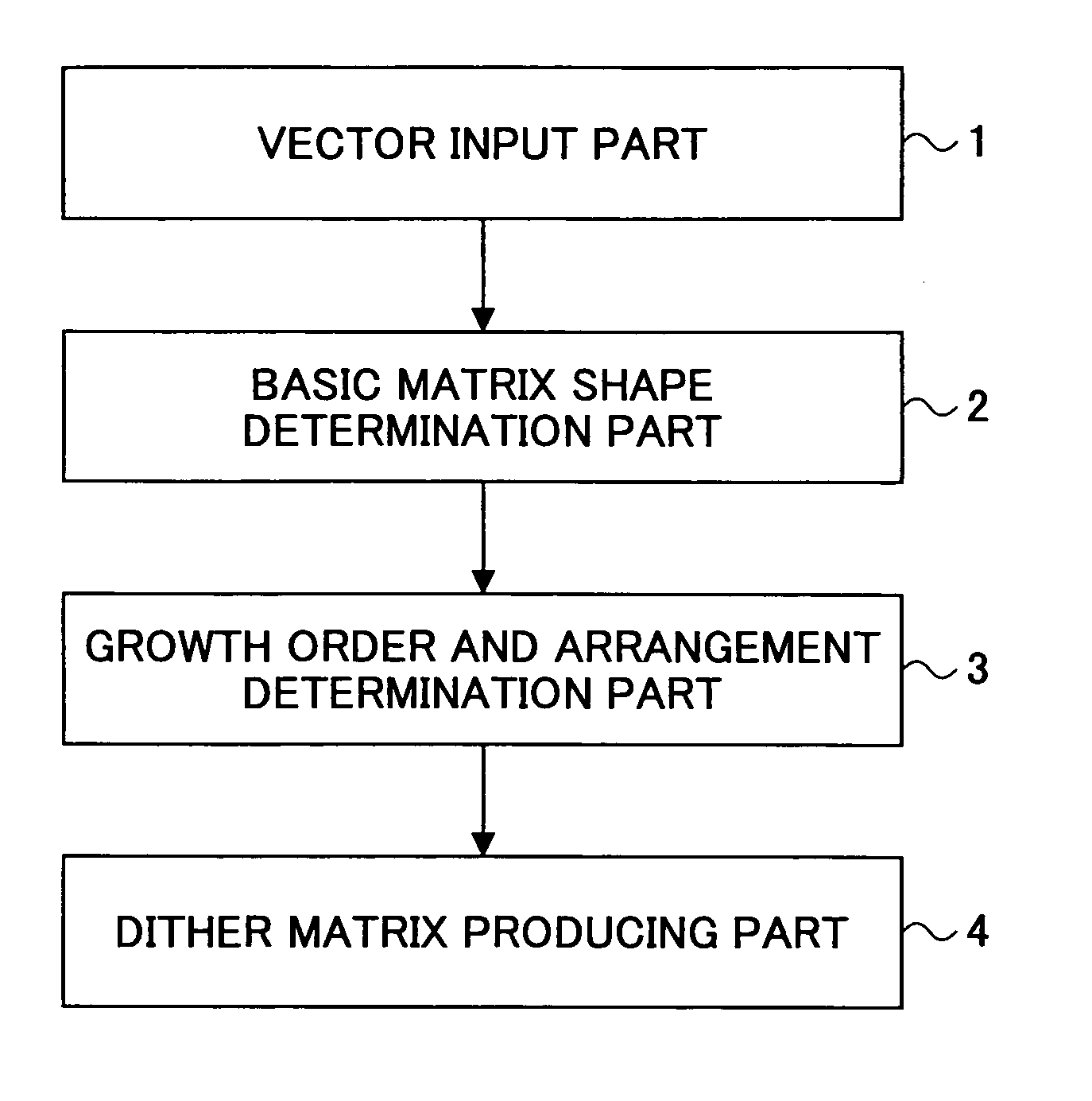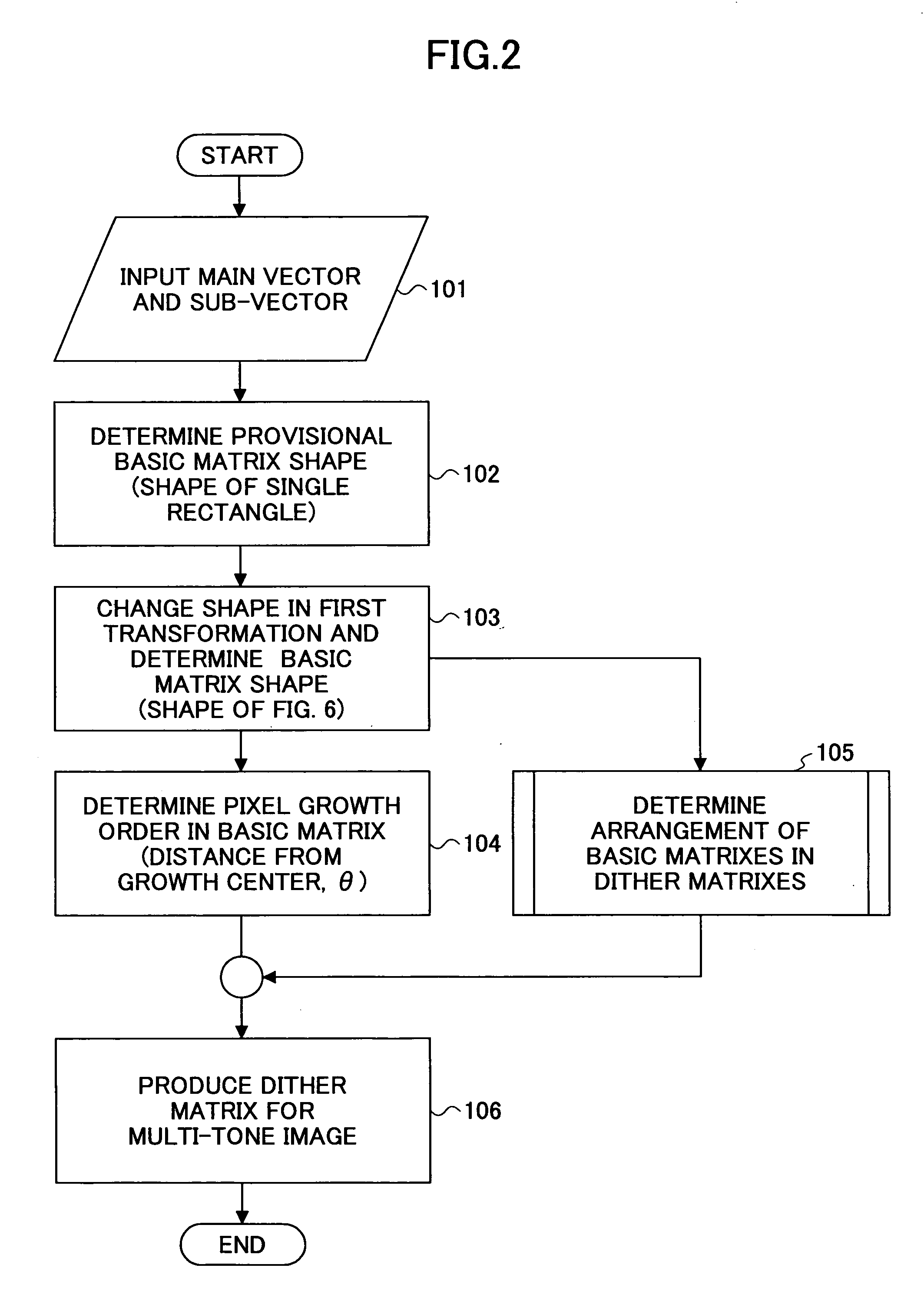Dither matrix producing method and apparatus, image processing method and apparatus, image forming method and apparatus, program and recording medium
a matrix and matrix technology, applied in the field of dither matrix producing method and apparatus, image processing method and apparatus, image forming method and apparatus, program and recording medium, etc., can solve the problems of insufficient tone reproducibility, adverse influence due to the spread of each dot, and degraded tone characteristics
- Summary
- Abstract
- Description
- Claims
- Application Information
AI Technical Summary
Problems solved by technology
Method used
Image
Examples
first embodiment
[0044] In particular, a process of determining a basic matrix shape in a process of producing the dot concentration type dither matrix is generally difficult since there is a requirement that the basic matrix should be disposed cyclically. Therefore, an ideal basic matrix shape cannot be derived easily according to the prior art. As a result, there may frequently occur a problematic situation in which the basic matrix shape, which has not compatible with a dot growth order in the dot concentration type dither matrix, is produced. Consequently, it should be efficient to produce the dither matrix trusting experience or intuition of an expert in the prior art. For example, as described later, the present invention has a basic matrix shape as shown in FIG. 4, for example. By disposing it in such a manner as to achieve a cyclic structure designated by a main vector and a sub-vector, it becomes possible to achieve an ‘exactly fit’ arrangement as shown in FIG. 7. At this time, a fact that ...
second embodiment
[0057] According to the present invention, a dither matrix producing method to arrange basic matrixes cyclically includes the steps of: a) defining two vectors determining a cyclic structure of the basic matrixes as below:
main vector: m{circumflex over ( )}=(mx, my); and
sub-vector: s{circumflex over ( )}=(sx, sy);
[0058] b) defining a positional vector of a pixel of the basic matrix, as below:
Pi{circumflex over ( )}=(Pix, Piy)
where the suffix i denotes an i-th pixel of the basic matrix; c) arranging the pixels of the basic matrix in such a manner to fulfill a requirement of the cyclic structure determined in the step a); then, d) performing transformation according to the following formula:
Pi{circumflex over ( )}→Pi{circumflex over ( )}+km{circumflex over ( )}+ls{circumflex over ( )}
where k and l are arbitrary integers which may be negative values, and thus, applying Pi{circumflex over ( )}+km{circumflex over ( )}+ls{circumflex over ( )} as a new pixel positional vector Pi{circumfl...
third embodiment
[0060] According to the present invention, a dither matrix producing method in which a cyclic structure of basic matrixes is determined by two vectors, includes the steps of a) defining the two vectors as below:
main vector: m{circumflex over ( )}=(mx, my); and
sub-vector: s{circumflex over ( )}=(sx, sy);
[0061] b) defining a positional vector of a pixel of the basic matrix, as below:
Pi{circumflex over ( )}=(Pix, Piy)
where the suffix i denotes an i-th pixel of the basic matrix; c) arranging the pixels of the basic matrix in such a manner that arrangement of the pixels of the basic matrix fulfils a requirement of the following formula:
|Pi{circumflex over ( )}|≦|Pi{circumflex over ( )}+km{circumflex over ( )}+ls{circumflex over ( )}|
where k and l are arbitrary integers, which may be negative values or zeros.
[0062] As a result of producing the basic matrix shape according to the above-mentioned relationship according to the third embodiment of the present invention, it is possible to s...
PUM
 Login to View More
Login to View More Abstract
Description
Claims
Application Information
 Login to View More
Login to View More - R&D
- Intellectual Property
- Life Sciences
- Materials
- Tech Scout
- Unparalleled Data Quality
- Higher Quality Content
- 60% Fewer Hallucinations
Browse by: Latest US Patents, China's latest patents, Technical Efficacy Thesaurus, Application Domain, Technology Topic, Popular Technical Reports.
© 2025 PatSnap. All rights reserved.Legal|Privacy policy|Modern Slavery Act Transparency Statement|Sitemap|About US| Contact US: help@patsnap.com



